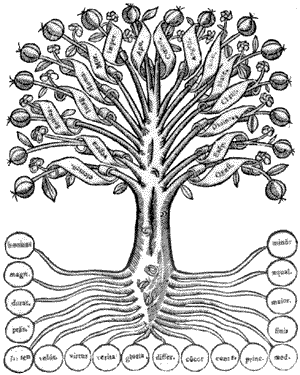héxis: estado, característica, hábito
Para Aristóteles há três estados na alma: emoções (pathe), capacidades (dynameis), características (hexeis) (Ethica Nichomacos 1105b). Hexis é definida (ibid.) como a nossa condição vis-à-vis aos pathe. A arete é uma hexis (ibid. 1106a); só o começo dos nossos hábitos está sob controle voluntário (ibid. 1114b). Os estoicos discordaram de Aristóteles e consideraram a arete mais uma diathesis do que uma hexis (SVF I, 202; II, 393). Um desenvolvimento genuinamente estoico do termo é o agrupamento da hexis com os quatro poderes unificadores das coisas: hexis, physis, psyche, noûs, e é traduzido, quando usado neste sentido por Séneca (Nat. Quaes. II, 2) como imitas (ver o uso particularmente semelhante de hexis em Platão citado na rubrica phthora). Entre estes a hexis é a unitas da matéria inorgânica (ver Sexto Empírico, Adv. Math. IX, 81-85; Fílon, Leg. ali. II, 22, Quod Deus 35; SVF II, 457-460, 714-716). A hexis é definida, na categoria da qualidade (poion) e distinguida do estado mais transitório, a disposição (diathesis), Cat. 8b-9a. (FEPeters)
héxis: estado, característica, hábito
Para Aristóteles há três estados na alma: emoções (pathe), capacidades (dynameis), características (hexeis) (Ethica Nichomacos 1105b). Hexis é definida (ibid.) como a nossa condição vis-à-vis aos pathe. A arete é uma hexis (ibid. 1106a); só o começo dos nossos hábitos está sob controle voluntário (ibid. 1114b). Os estoicos discordaram de Aristóteles e consideraram a arete mais uma diathesis do que uma hexis (SVF I, 202; II, 393). Um desenvolvimento genuinamente estoico do termo é o agrupamento da hexis com os quatro poderes unificadores das coisas: hexis, physis, psyche, nous, e é traduzido, quando usado neste sentido por Séneca (Nat. Quaes. II, 2) como imitas (ver o uso particularmente semelhante de hexis em Platão citado na rubrica phthora). Entre estes a hexis é a unitas da matéria inorgânica (ver Sexto Empírico, Adv. Math. IX, 81-85; Fílon, Leg. ali. II, 22, Quod Deus 35; SVF II, 457-460, 714-716). A hexis é definida, na categoria da qualidade (poion) e distinguida do estado mais transitório, a disposição (diathesis), Cat. 8b-9a. (FEPeters)
héxis: estado, característica, hábito
Para Aristóteles há três estados na alma: emoções (pathe), capacidades (dynameis), características (hexeis) (Ethica Nichomacos 1105b). Hexis é definida (ibid.) como a nossa condição vis-à-vis aos pathe. A arete é uma hexis (ibid. 1106a); só o começo dos nossos hábitos está sob controle voluntário (ibid. 1114b). Os estoicos discordaram de Aristóteles e consideraram a arete mais uma diathesis do que uma hexis (SVF I, 202; II, 393). Um desenvolvimento genuinamente estoico do termo é o agrupamento da hexis com os quatro poderes unificadores das coisas: hexis, physis, psyche, nous, e é traduzido, quando usado neste sentido por Séneca (Nat. Quaes. II, 2) como imitas (ver o uso particularmente semelhante de hexis em Platão citado na rubrica phthora). Entre estes a hexis é a unitas da matéria inorgânica (ver Sexto Empírico, Adv. Math. IX, 81-85; Fílon, Leg. ali. II, 22, Quod Deus 35; SVF II, 457-460, 714-716). A hexis é definida, na categoria da qualidade (poion) e distinguida do estado mais transitório, a disposição (diathesis), Cat. 8b-9a. (FEPeters)
